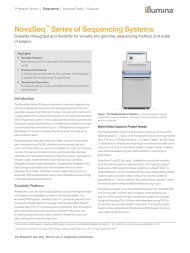Abstracts
ngsfinalprogram
ngsfinalprogram
You also want an ePaper? Increase the reach of your titles
YUMPU automatically turns print PDFs into web optimized ePapers that Google loves.
Oral Presentation <strong>Abstracts</strong><br />
utility of Salmonella serotyping when integrated<br />
into a platform of WGS-based pathogen<br />
subtyping and characterization.<br />
n S4:5<br />
PATRIC PIPELINE<br />
F. Xia 1 , T. Brettin 2 , S. Boisvert 2 , N. R. Conrad 2 ,<br />
J. J. Davis 1 , T. Disz 1 , J. Edirisinghe 2 , R. A. Edwards<br />
3 , C. Henry 1 , R. W. Kenyon 4 , D. Machi 4 ,<br />
C. Mao 4 , G. J. Olsen 5 , R. Olson 2 , R. Overbeek 6 ,<br />
B. Parrello 6 , G. D. Pusch 6 , M. P. Shukla 2 , B. W.<br />
Sobral 4 , R. L. Stevens 1 , V. Vonstein 6 , A. Warren<br />
4 , R. Will 4 , H. Yoo 4 , A. R. Wattam 4 ;<br />
1<br />
University of Chicago, Chicago, IL, 2 Argonne<br />
National Laboratory, Lemont, IL, 3 San Diego<br />
State University, San Diego, CA, 4 Virginia<br />
Tech, Blacksburg, VA, 5 University of Illinois<br />
at Urbana and Champaign, Urbana, IL, 6 Fellowship<br />
for Interpretation of Genomes, Burr<br />
Ridge, IL.<br />
Recent advances in DNA sequencing technology<br />
accompanied by plummeting per-base cost<br />
is making sequence-based applications more<br />
amenable. While a plethora of bioinformatics<br />
databases and workflows exist, their capabilities<br />
are often hampered by the inconsistent<br />
use of analysis tools. PATRIC, the NIAIDfunded<br />
comprehensive bacterial bioinformatics<br />
resource, has integrated more than 30,000<br />
consistently annotated prokaryote genomes<br />
with a focus on human pathogenic species.<br />
Here we present PATRIC’s new computational<br />
services that support the assembly, annotation<br />
and metabolic modeling of user-supplied<br />
genomes in the same consistent fashion. These<br />
services, integrated with PATRIC’s collections<br />
of specialty genes such as antibiotic resistance<br />
determinants and virulence factors, will enable<br />
users to rapidly process newly sequenced<br />
pathogens and investigate key pathogenic<br />
determinants in foodborne outbreaks using the<br />
powerful visualization and comparative analysis<br />
tools in PATRIC. We have implemented<br />
the new services with three principles in mind.<br />
(1) Controlled vocabulary. At the heart of<br />
PATRIC’s annotation service is a controlled<br />
vocabulary for functional annotation derived<br />
from the curated subsystems and protein families<br />
in the RAST and SEED systems [2]. Similarly,<br />
the new model reconstruction service<br />
relies on our curated biochemistry data [5].<br />
These curation efforts ensure newly sequenced<br />
genomes can be automatically annotated and<br />
modeled and readily compared with existing<br />
reference data. (2) Modular design. In genome<br />
assembly as well as other bioinformatic analyses,<br />
there is often no single tool best suited<br />
for all occasions [4]. We have added support<br />
for more than 30 tools for error correction,<br />
contig assembly, scaffolding, contig evaluation,<br />
consensus building, gene calling, overlap<br />
removal, as well as many custom algorithms<br />
[3]. These modules are condensed into a few<br />
curated workflows to ensure convenient and<br />
efficient execution as well as consistent quality<br />
control. (3) Integrated analysis. The new<br />
workspace allows users to upload their own<br />
data for analysis, and upon completion the<br />
private results are immediately integrated into<br />
PATRIC. This enables users to take advantage<br />
of PATRIC’s data (drug targets, omics, AMR<br />
and other clinical metadata) and comparative<br />
tools (protein family sorter, phylogeny, heat<br />
maps, etc). In addition to these services, we<br />
are actively building support for batch analysis<br />
and SNP-level comparative analysis for closely<br />
related genomes. URL: https://www.patricbrc.<br />
org. References: [1] Gillespie, et al. “PATRIC:<br />
... (2011). [2] Overbeek, et al. “The SEED<br />
... (RAST).” Nucleic acids research (2014):<br />
D206-D214. [3] Brettin, et al. “RASTtk ...”<br />
Scientific reports 5 (2015). [4] Earl, et al. “Assemblathon<br />
...” Genome research (2011). [5]<br />
Henry, et al. “High-throughput ... models.”<br />
Nature biotechnology (2010).<br />
22<br />
ASM Conferences



